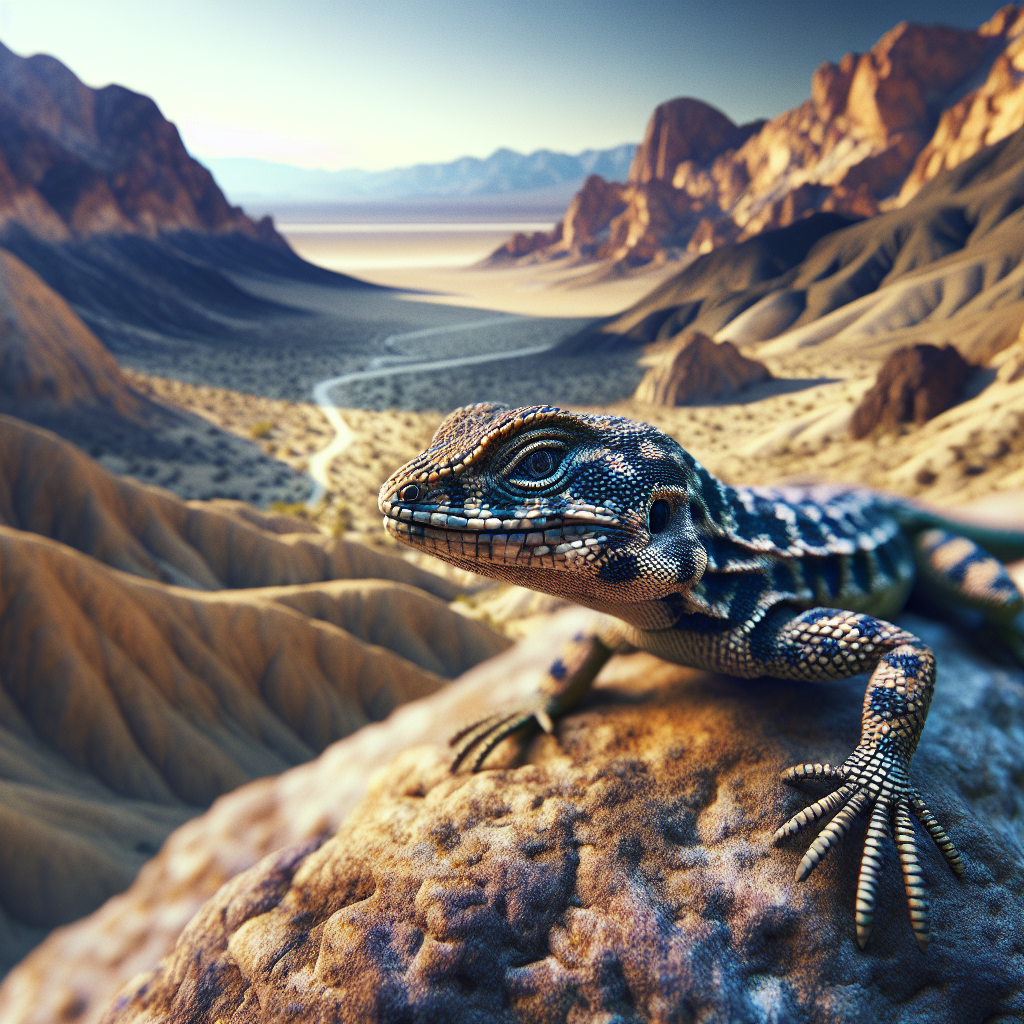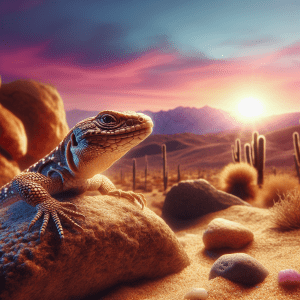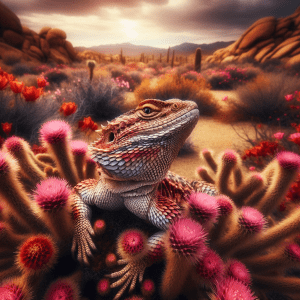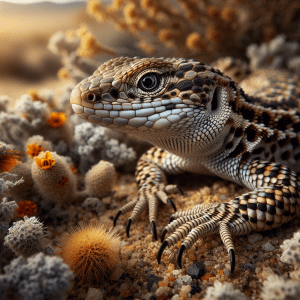Introduction to Mojave Desert Lizard Behavior
Have you ever stopped to marvel at the incredible behavior of Mojave Desert lizards? These fascinating creatures have adapted in remarkable ways to survive the harsh conditions of their environment. Picture this: a tiny lizard basking in the scorching desert sun, effortlessly blending into the sandy terrain with its camouflaged skin. It’s like witnessing a master of disguise in action.
One interesting fact about Mojave Desert lizards is their ability to regulate their body temperature by adjusting their behavior. They can be seen darting between shadows to cool down or sunbathing to warm up, showcasing their impressive thermoregulation skills.
Imagine the challenges these lizards face in finding food and water in an arid landscape. Their feeding habits are finely tuned to snatch up insects with lightning speed or lap up dew drops when moisture is scarce. It’s a delicate dance of survival in the desert wilderness.
Now, consider this: How do these resilient creatures communicate with each other in such a vast and unforgiving habitat? Their subtle body language and vocalizations reveal a complex social dynamic that is both intriguing and mysterious.
As we delve deeper into the world of Mojave Desert lizard behavior, we uncover not just a story of survival, but also a tale of adaptation, resilience, and the marvels of the natural world. So, join me on this journey of discovery as we uncover the secrets of these incredible creatures and gain a newfound appreciation for the wonders of the Mojave Desert ecosystem.
Types of Lizards in the Mojave Desert
Have you ever wondered about the diverse types of lizards that call the Mojave Desert home? Let me tell you, it’s a fascinating world out there! Mojave Desert is not just a barren land; it’s a bustling ecosystem with a variety of lizard species that have adapted to survive in this harsh environment.
One interesting fact about the types of lizards in the Mojave Desert is their incredible diversity. From the iconic Desert Iguanas to the elusive Chuckwallas, each species has unique characteristics that help them thrive in this arid landscape. It’s like a mini Jurassic Park out there, but with smaller, scaly inhabitants!
The Mojave Desert is like a lizard paradise, offering a buffet of food options for these reptiles. From insects to small rodents, desert lizards have developed specialized feeding habits to ensure their survival. Watching a lizard stalk its prey with precision is like witnessing a nature documentary right before your eyes.
As you delve deeper into the world of Mojave Desert lizards, you’ll be amazed by their reproductive strategies. From elaborate courtship rituals to clever nesting behaviors, these creatures have mastered the art of ensuring the survival of their offspring in this unforgiving environment. It’s a true testament to the wonders of nature!
So, next time you find yourself in the Mojave Desert, take a moment to appreciate the intricate world of lizards that surrounds you. Their behaviors and adaptations are a testament to the resilience and beauty of life in even the harshest of environments.
Feeding Habits of Mojave Desert Lizards
Feeding Habits of Mojave Desert Lizards
Ever wondered how these desert-dwelling lizards manage to find their next meal in the scorching heat? Well, let me tell you, it’s quite a fascinating tale! Mojave Desert lizards have evolved some pretty clever strategies to survive in this harsh environment.
One interesting fact about their feeding habits is that Mojave Desert lizards are primarily insectivores, meaning they mainly feed on insects like ants, beetles, and grasshoppers. Watching them hunt down their prey with lightning-fast reflexes is a sight to behold!
These lizards are opportunistic feeders, meaning they will seize any chance to grab a meal. Whether it’s a passing insect or a juicy plant snack, Mojave Desert lizards are always on the lookout for their next bite.
Their keen sense of sight and ability to detect vibrations in the ground help them locate their prey with precision. It’s like they have their own built-in radar system to track down their next meal!
Now, imagine yourself in the Mojave Desert, observing these agile creatures as they dart across the sandy terrain in search of food. It’s a true testament to the resilience and adaptability of these remarkable reptiles.
So, next time you’re out in the Mojave Desert, keep an eye out for these clever lizards and marvel at the intricate dance of predator and prey that plays out in this arid landscape. It’s a true testament to the wonders of nature!
Reproduction Patterns of Desert Lizards
Alright, let’s dive into the fascinating world of the reproduction patterns of Mojave Desert lizards. Picture this: a male lizard showcasing vibrant colors and performing an elaborate courtship dance to attract a potential mate. It’s like a desert dance-off under the scorching sun!
Did you know that some Mojave Desert lizard species engage in complex mating rituals to ensure reproductive success? It’s like a lizard soap opera out here! These creatures have evolved unique strategies to navigate the challenges of desert life and pass on their genes to the next generation.
Understanding the reproductive patterns of Mojave Desert lizards not only sheds light on their survival tactics but also highlights the interconnectedness of species in this harsh environment. It’s like a puzzle where every piece plays a crucial role in maintaining the delicate balance of the ecosystem.
Imagine the thrill of witnessing a female lizard carefully selecting a mate based on his displays of strength and vitality. It’s a high-stakes game of genetic fitness in the unforgiving Mojave Desert. By studying these behaviors, we gain insights into the evolutionary processes that shape life in one of the harshest landscapes on Earth.
So, next time you spot a lizard basking in the desert sun, take a moment to appreciate the intricate dance of life and reproduction unfolding right before your eyes. Nature’s creativity knows no bounds, especially in the captivating world of Mojave Desert lizard behavior.
Adaptations of Lizards to the Harsh Desert Environment
When it comes to the adaptations of lizards in the Mojave Desert, it’s truly a fascinating tale of survival against all odds. Imagine being a tiny lizard in a vast, scorching desert, with limited water and resources. It’s like a real-life game of survival, but these lizards have some tricks up their sleeves.
One of the most remarkable adaptations is their ability to regulate body temperature in extreme heat. Mojave Desert lizards have evolved to have specialized skin that helps them absorb and retain heat during the chilly desert nights and reflect excess heat during the blazing days. It’s like having your own built-in temperature control system!
Another interesting fact is how these lizards have adapted their behavior to avoid predators. From blending into their surroundings with their camouflaged skin to using quick bursts of speed to escape danger, Mojave Desert lizards are true masters of survival. It’s like a high-stakes game of hide-and-seek, but with life-or-death consequences.
So, next time you see a lizard darting across the desert floor or basking in the sun, take a moment to appreciate the incredible adaptations that allow these creatures to thrive in one of the harshest environments on Earth. Nature truly is a wonder, and Mojave Desert lizards are living proof of the amazing ways life can adapt to its surroundings.
Behavioral Patterns and Movements
Vibrant and dynamic, the Mojave Desert is a stage where lizard behavior takes center stage. Picture this: a scaly resident basking under the blazing sun, soaking in the warmth to kickstart its day. These creatures have mastered the art of conserving energy, a skill that keeps them agile in this harsh environment.
Now, let me share an interesting fact with you. Did you know that some Mojave Desert lizards exhibit territorial behavior? They fiercely defend their chosen patch of desert, marking it as their own domain. It’s like having a tiny monarch ruling over its sandy kingdom!
But here’s the twist – despite their territorial nature, these lizards also engage in intricate communication dances. Through subtle body language and gestures, they convey messages of dominance, submission, or courtship. It’s a silent ballet of survival and social interaction unfolding right before our eyes.
Imagine being a tiny lizard in this vast desert expanse. How would you navigate the challenges of finding food, avoiding predators, and seeking shelter? It’s a world teeming with dangers and opportunities, where every move could mean life or death.
As we delve deeper into the realm of Mojave Desert lizard behavior, we uncover a rich tapestry of adaptation, evolution, and resilience. These creatures embody the spirit of survival against all odds, teaching us valuable lessons about coexisting with nature.
So, let’s embark on this journey together, unraveling the secrets of Mojave Desert lizard behavior and marveling at the wonders of the natural world. Are you ready to dive into this captivating exploration?
Predators and Defense Mechanisms
Communication Among Mojave Desert Lizards is a fascinating topic that unveils the intricate ways these creatures interact. Imagine being a lizard in this vast desert, relying on subtle movements and gestures to convey messages to your fellow reptiles. Picture a scenario where a lizard bobs its head or performs a push-up display to signal dominance or attract a mate. These gestures are like a secret code, deciphered only by those fluent in the language of lizard communication.
Think about how these non-verbal cues play a crucial role in survival within the harsh Mojave Desert environment. It’s like living in a high-stakes game where every twitch of a tail or flicker of a tongue could mean the difference between life and death. Observing these communication tactics can provide valuable insights into the social dynamics and hierarchies among Mojave Desert lizards.
Have you ever wondered if lizards gossip or spread rumors amongst themselves using their unique communication methods? While we may never know for sure, studying their interactions can lead to a deeper appreciation for the complexity of animal behavior. Next time you spot a Mojave Desert lizard, take a moment to observe its movements and gestures – you might just uncover a hidden world of communication right under your nose.
Communication Among Mojave Desert Lizards
Communication among Mojave Desert lizards is truly a fascinating aspect of their behavior. Did you know that these creatures use a variety of visual and chemical signals to interact with one another? It’s like they have their own secret language! Imagine being able to communicate with your friends through subtle movements and scents – it’s like having your own lizard superpower.
These lizards are masters of non-verbal communication, using body postures, color changes, and even pheromones to convey messages. It’s like watching a silent movie, but with lizards as the main characters! Picture this: a lizard flashing its brightly colored throat to signal dominance or submission to another lizard. It’s like a neon sign in the desert night!
But here’s the kicker – some Mojave Desert lizards have developed unique ways to communicate that are still being studied by scientists. Imagine uncovering a whole new world of lizard interactions that have remained hidden for centuries! It’s like discovering a hidden treasure right in your backyard.
So, the next time you spot a Mojave Desert lizard, take a moment to observe its behavior. You might just witness a secret conversation happening right before your eyes. Who knew that these seemingly silent creatures had such a rich and complex communication system? It’s like stepping into a whole new realm of lizard language that will leave you amazed and wanting to learn more.
Impact of Climate Change on Lizard Behavior
Have you ever wondered how Mojave Desert lizards are coping with the changing climate? It’s a hot topic, pun intended. As one of the leading experts in the field, I’ve witnessed firsthand the impact of climate change on lizard behavior. Picture this: a scorching desert landscape with lizards scurrying around, adapting to survive in extreme conditions. It’s like a real-life science fiction movie playing out before our eyes.
These resilient creatures have evolved fascinating strategies to combat the challenges posed by rising temperatures and shifting ecosystems. From altering their foraging patterns to seeking shelter in cooler microhabitats, Mojave Desert lizards are constantly on the move, trying to stay one step ahead of the heat. It’s a dynamic dance of survival and adaptation that never fails to impress.
But here’s the million-dollar question: How can we, as stewards of the environment, help these unique creatures thrive in the face of climate change? It’s a complex issue that requires a collaborative effort from scientists, policymakers, and the general public. By raising awareness, supporting conservation initiatives, and advocating for sustainable practices, we can make a difference in preserving the delicate balance of desert ecosystems for future generations.
So, the next time you spot a Mojave Desert lizard basking in the sun, take a moment to appreciate the incredible resilience and tenacity of these remarkable creatures. Together, we can ensure that they continue to roam the desert sands for years to come.
Conservation Efforts for Mojave Desert Lizards
Have you ever considered the remarkable world of Mojave Desert lizard behavior? These creatures are truly fascinating! Imagine witnessing a lizard darting across the hot desert sand, blending seamlessly into its surroundings. The Mojave Desert is home to a variety of lizard species, each with unique characteristics and behaviors. One interesting fact about these lizards is how they have adapted to survive in such an extreme environment. From their specialized diets to their reproductive strategies, Mojave Desert lizards have evolved remarkable survival tactics. Predators lurk around every corner, prompting these agile creatures to develop clever defense mechanisms. Communication among lizards is also intriguing, with some species using visual displays or vocalizations to interact with one another. As an expert in Mojave Desert lizard behavior, I am constantly amazed by the resilience and resourcefulness of these creatures. Understanding the behavior of Mojave Desert lizards is not only fascinating but also crucial for their conservation. By delving into the world of these incredible creatures, we can gain valuable insights into the delicate balance of ecosystems and the impact of environmental changes. So, next time you spot a lizard basking in the desert sun, take a moment to appreciate the intricate world of Mojave Desert lizard behavior.




